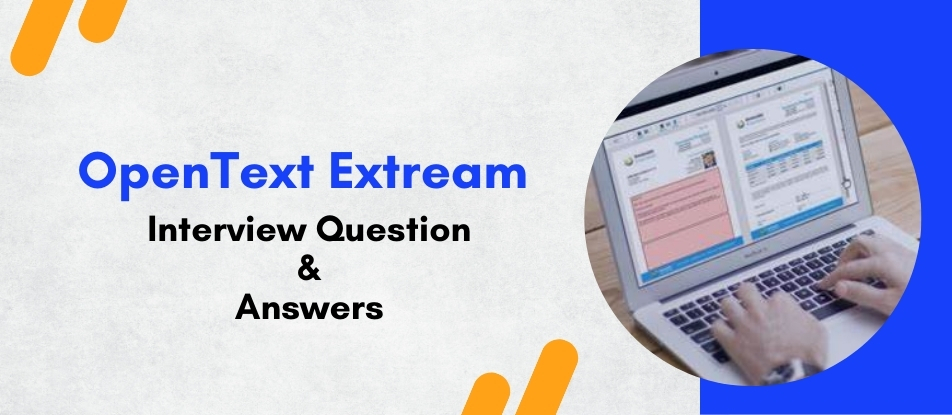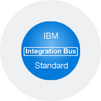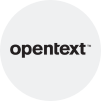
The OpenText Exstream Training course provides in-depth knowledge of creating and managing personalized customer communications. Participants will master template design, data integration, and multi-channel delivery for high-volume and interactive documents. This hands-on training focuses on advanced features like scripting, workflow automation, and compliance management, empowering professionals to enhance customer engagement while optimizing communication processes. Ideal for industries like finance, healthcare, and utilities.
OpenText Extream Training Interview Questions Answers - For Intermediate
1. How does OpenText Exstream handle high-volume transactional communications?
OpenText Exstream is designed to manage high-volume transactional communications like invoices, statements, and bills efficiently. By leveraging its batch processing capabilities, the software can process large datasets, integrate them with predefined templates, and generate personalized communications. Its scalable architecture ensures that it can handle millions of transactions while maintaining speed and accuracy, making it ideal for enterprises dealing with customer data at scale.
2. What role does the Composition Center play in OpenText Exstream?
The Composition Center in OpenText Exstream is a tool that allows business users to create, edit, and manage templates and content without relying heavily on IT. It empowers users to design and modify templates in real-time, ensuring faster turnaround for communication changes. This is particularly useful for organizations requiring frequent updates to customer communications due to regulatory changes or marketing campaigns.
3. What is the significance of advanced conditional logic in OpenText Exstream?
Advanced conditional logic allows OpenText Exstream to personalize communications dynamically. By defining rules based on customer data, such as location, preferences, or transaction history, the platform can tailor content to meet individual needs. This ensures that communications are relevant, enhances customer satisfaction, and increases the effectiveness of campaigns.
4. How does OpenText Exstream integrate with CRM systems?
OpenText Exstream integrates seamlessly with CRM systems like Salesforce and Microsoft Dynamics by using APIs and connectors. This integration allows the software to pull customer data directly from the CRM and use it to generate personalized communications. The result is a streamlined workflow where customer interactions are recorded, and communications are tailored to maintain consistency across touchpoints.
5. What is the purpose of scripting in OpenText Exstream, and when is it used?
Scripting in OpenText Exstream is used to extend the platform’s functionality by adding custom logic or data manipulation processes. It is commonly employed for complex scenarios where out-of-the-box features may not suffice. For example, scripts can automate calculations, validate input data, or format output to meet specific business requirements.
6. What are the key components of OpenText Exstream’s design environment?
The design environment of OpenText Exstream includes tools like Design Manager, Composition Center, and scripting capabilities. These components enable users to create templates, define workflows, and incorporate conditional logic. Design Manager focuses on template creation, while Composition Center caters to business users for quick edits. Together, these tools provide a comprehensive solution for managing customer communications.
7. How does OpenText Exstream handle interactive communications?
Interactive communications in OpenText Exstream allow users to generate documents in real-time based on customer interactions. For instance, during a customer service call, the system can use live inputs to create a personalized quote or contract. This feature ensures that communications are immediate, accurate, and tailored to the specific interaction.
8. What are the security features available in OpenText Exstream?
OpenText Exstream provides robust security features, including data encryption, user access controls, and audit trails. It ensures that sensitive customer data is protected during processing and transmission. Role-based access control restricts user permissions, ensuring that only authorized personnel can access specific templates or workflows.
9. How do you optimize OpenText Exstream for better performance?
Optimizing OpenText Exstream involves steps like efficient template design, minimizing redundant workflows, and using indexed data sources. It also includes monitoring system performance and scaling resources based on workload demands. Regularly updating the software and conducting performance audits can further ensure smooth operations.
10. What are the main types of outputs generated by OpenText Exstream?
OpenText Exstream supports various output formats, including PDFs, HTML, XML, and print-ready formats like PostScript. These outputs cater to different communication channels, such as email, web, and physical mail. The platform ensures that the format aligns with the requirements of the delivery method, enhancing compatibility and user experience.
11. How does OpenText Exstream support compliance with data privacy regulations?
OpenText Exstream supports compliance by providing tools for secure data handling, auditing, and access control. Features like encryption and logging ensure that sensitive customer data is processed and stored securely. The platform also allows organizations to implement workflows that comply with regulations like GDPR, ensuring that personal data is handled responsibly.
12. What are the benefits of using OpenText Exstream for personalized marketing?
OpenText Exstream enables personalized marketing by allowing organizations to create dynamic content tailored to individual customer profiles. By integrating with CRM systems and leveraging conditional logic, the platform can generate targeted messages that resonate with customers. This increases engagement, improves conversion rates, and enhances the overall customer experience.
13. How does OpenText Exstream manage multilingual communications?
OpenText Exstream supports multilingual communications by allowing templates to include content in multiple languages. It uses dynamic content rules to select the appropriate language based on customer data. Additionally, it supports character sets for different scripts, ensuring accurate representation of text in languages like Chinese, Arabic, or Russian.
14. What is the purpose of proofing tools in OpenText Exstream?
Proofing tools in OpenText Exstream allow users to preview and validate templates before finalizing them. These tools ensure that the layout, dynamic content, and data mapping function as expected. By catching errors early, proofing tools reduce the risk of miscommunications and enhance the quality of customer interactions.
15. How does OpenText Exstream support scalability for growing businesses?
OpenText Exstream’s modular architecture and robust processing capabilities make it highly scalable. As a business grows, the platform can handle increased volumes of data and communications without significant performance degradation. Its ability to integrate with enterprise systems and support cloud deployments further ensures that it can meet the demands of expanding organizations.
OpenText Extream Training Interview Questions Answers - For Advanced
1. How does OpenText Exstream handle large-scale migrations from legacy CCM platforms?
Migrating from legacy CCM platforms to OpenText Exstream involves several steps, including data mapping, template conversion, and workflow redesign. Exstream provides tools to streamline migration, such as the ability to import legacy templates and adapt them to its design framework. However, challenges like data inconsistencies and outdated processes often arise. To address these, organizations need to conduct thorough assessments of existing systems, clean and standardize data, and develop new workflows that leverage Exstream’s advanced features. Testing is crucial to ensure the migrated content aligns with business requirements. With proper planning and phased implementation, large-scale migrations can be executed efficiently.
2. What advanced features does OpenText Exstream offer for regulatory document generation?
For regulatory document generation, OpenText Exstream provides features like automated rule enforcement, dynamic content generation, and audit trails. Templates can be configured with conditional logic to include mandatory disclosures or legal clauses based on the document type and recipient’s jurisdiction. The platform’s audit trail functionality ensures traceability, allowing organizations to track changes and validate compliance. Furthermore, Exstream supports secure output delivery and document archiving, ensuring that regulatory records are accessible for audits and legal purposes.
3. How does OpenText Exstream ensure scalability for enterprises handling billions of transactions annually?
OpenText Exstream’s architecture is built to scale for enterprises managing high transaction volumes. It supports distributed processing across multiple servers, which allows workloads to be balanced dynamically. Its robust data handling capabilities, including indexed data sources and high-performance processing engines, ensure that it can process large datasets efficiently. By leveraging cloud infrastructure, Exstream can scale resources up or down based on demand, making it ideal for enterprises experiencing seasonal spikes or rapid growth.
4. What are the most common performance bottlenecks in OpenText Exstream, and how are they mitigated?
Performance bottlenecks in OpenText Exstream often occur due to inefficient workflows, complex templates, or poorly optimized data sources. For example, templates with excessive conditional logic or large, unindexed datasets can slow processing. These issues can be mitigated by simplifying template designs, optimizing data queries, and leveraging Exstream’s distributed processing capabilities. Regular performance monitoring and proactive resource allocation also help in identifying and addressing bottlenecks before they impact operations.
5. How does OpenText Exstream manage multi-tenant environments in shared service models?
In a multi-tenant environment, OpenText Exstream ensures data isolation and security for each tenant through role-based access controls and compartmentalized workflows. Templates and resources can be assigned to specific tenants, preventing unauthorized access. The platform’s scalability allows shared services to handle multiple tenants efficiently without performance degradation. Customization options enable each tenant to maintain their branding and compliance requirements while leveraging shared infrastructure.
6. What role does machine learning (ML) play in OpenText Exstream’s communication optimization?
Machine learning enhances OpenText Exstream by enabling predictive analytics and intelligent decision-making in customer communications. For instance, ML algorithms can analyze customer behavior to recommend the most effective communication channel or content type. By integrating ML with Exstream, organizations can automate processes like offer selection, message timing, and customer segmentation, improving engagement and ROI. While Exstream itself doesn’t natively include ML, its open architecture allows integration with ML platforms and tools.
7. What are the challenges of delivering communications across international markets, and how does OpenText Exstream address them?
Delivering communications internationally involves challenges like language barriers, compliance with local regulations, and varying delivery infrastructure. OpenText Exstream addresses these challenges through multilingual template support, dynamic content generation, and compliance workflows. Templates can include content in multiple languages, dynamically selecting the appropriate one based on customer data. Exstream also ensures compliance by automating region-specific rules and supporting various communication formats suitable for local infrastructures.
8. How can OpenText Exstream be integrated into a DevOps pipeline?
Integrating OpenText Exstream into a DevOps pipeline requires automating deployment, testing, and version control processes. Exstream’s templates and workflows can be stored in repositories like Git, enabling version control and collaborative development. Automated testing frameworks can validate template functionality and data integration. Deployment scripts ensure that updates are rolled out seamlessly across environments. By incorporating Exstream into DevOps, organizations can reduce deployment cycles and improve the reliability of their communication workflows.
9. Explain the significance of real-time monitoring and reporting in OpenText Exstream.
Real-time monitoring and reporting in OpenText Exstream are critical for ensuring operational efficiency and identifying issues proactively. The platform provides dashboards and logs that track the status of workflows, document generation, and delivery processes. Real-time insights enable organizations to detect and resolve errors, such as failed deliveries or data mismatches, before they impact customer experience. Reporting tools also provide performance metrics and compliance evidence, supporting both operational improvement and regulatory audits.
10. How does OpenText Exstream handle complex data transformations during communication generation?
OpenText Exstream handles complex data transformations using its built-in data mapping and scripting capabilities. Data from diverse sources can be cleaned, formatted, and enriched before being merged with templates. For example, Exstream can parse raw data files, apply business logic, and convert values into user-friendly formats like currency or dates. Custom scripts can also handle unique transformation requirements, ensuring that the final output meets business and regulatory standards.
11. What is the role of document composition in enhancing customer communication?
Document composition in OpenText Exstream involves assembling content, layout, and data into a final communication tailored to the recipient. Advanced composition capabilities allow dynamic layouts, conditional inclusion of elements, and multi-channel adaptability. For instance, a single template can generate a statement optimized for both print and email delivery. Effective document composition improves the clarity, relevance, and impact of customer communications, fostering better engagement and loyalty.
12. How does OpenText Exstream support disaster recovery and business continuity planning?
Disaster recovery and business continuity are supported by OpenText Exstream through features like automated backups, failover configurations, and cloud-based deployments. Templates, workflows, and system configurations can be stored in redundant environments to ensure quick restoration in case of system failure. Exstream’s ability to integrate with cloud services also enables organizations to leverage geographically distributed resources, reducing downtime and ensuring uninterrupted communication delivery.
13. What are the advanced automation capabilities in OpenText Exstream?
OpenText Exstream supports advanced automation through workflow management, conditional logic, and API integrations. Workflows can be designed to automate end-to-end processes, from data ingestion to multi-channel delivery. Conditional logic enables automated decision-making, such as selecting the appropriate template or delivery channel based on customer data. APIs allow seamless integration with enterprise systems, enabling automated triggers for document generation in response to business events.
14. How does OpenText Exstream address environmental sustainability in document generation?
OpenText Exstream supports environmental sustainability by promoting digital communication channels, reducing the need for physical printing and mailing. Its ability to deliver communications via email, web, and SMS significantly lowers paper consumption and carbon footprint. Additionally, the platform’s batch processing efficiency minimizes energy usage during high-volume operations. Organizations can further enhance sustainability by leveraging Exstream’s analytics to identify and eliminate waste in communication processes.
15. What are the best practices for designing reusable templates in OpenText Exstream?
Designing reusable templates in OpenText Exstream involves using modular design principles, dynamic content placeholders, and standardized styles. Templates should be broken into reusable components, such as headers, footers, and content blocks, which can be shared across multiple documents. Dynamic placeholders allow templates to adapt to different datasets and output requirements. Using consistent styles ensures branding uniformity while simplifying updates. Reusable templates improve efficiency, reduce maintenance effort, and enhance scalability.
Course Schedule
| Apr, 2025 | Weekdays | Mon-Fri | Enquire Now |
| Weekend | Sat-Sun | Enquire Now | |
| May, 2025 | Weekdays | Mon-Fri | Enquire Now |
| Weekend | Sat-Sun | Enquire Now |
Related Courses
Related Articles
Related Interview
- Certified Ethical Hacker (CEH) Training Interview Questions Answers
- Palantir Foundry Data Analyst Training Interview Questions Answers
- Salesforce Data Cloud Training Interview Questions Answers
- Structural Analysis Training Interview Questions and Answers
- AWS Certified Cloud Practitioner (AWS Cloud Practitioner) Interview Questions Answers
Related FAQ's
- Instructor-led Live Online Interactive Training
- Project Based Customized Learning
- Fast Track Training Program
- Self-paced learning
- In one-on-one training, you have the flexibility to choose the days, timings, and duration according to your preferences.
- We create a personalized training calendar based on your chosen schedule.
- Complete Live Online Interactive Training of the Course
- After Training Recorded Videos
- Session-wise Learning Material and notes for lifetime
- Practical & Assignments exercises
- Global Course Completion Certificate
- 24x7 after Training Support












 Join our Live Instructor-Led online classes delivered by industry experts
Join our Live Instructor-Led online classes delivered by industry experts